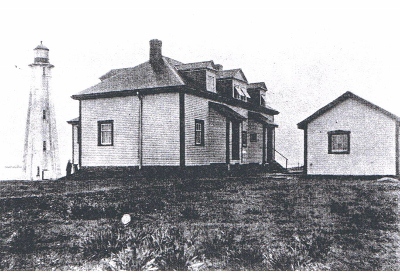Cape Anguille Lighthouse
Heritage Lighthouse
Codroy, Newfoundland and Labrador

Historic photograph
© Library and Archives Canada | Bibliothèque et archives Canada, PA-165244
Address :
Highway 406, Cape Anguille, Codroy, Newfoundland and Labrador
Recognition Statute:
Heritage Lighthouse Protection Act (S.C. 2008, c 16)
Designation Date:
2015-11-29
Dates:
-
1960 to 1960
(Construction)
-
1908 to 1908
(Established)
Event, Person, Organization:
-
R.G. McDougall Limited
(Builder)
Description of Historic Place
The Cape Anguille Lighthouse is a tapered, octagonal, reinforced-concrete lighthouse, measuring 17.7 metres (58 feet). It is located on insular Newfoundland’s most westerly point, within the Codroy Valley, a glacial valley formed in the Anguille Mountains. It is the second lighthouse on site, with the current tower dating to 1958-60.
There is one related building on the site that contributes to the heritage character of the lighthouse: (1) the 1990 Office Building.
Heritage Value
The Cape Anguille Lighthouse is a heritage lighthouse because of its historical, architectural, and community values.
Historical values
The Cape Anguille Lighthouse is an excellent example of the development of aids to navigation in Canadian waters. The west coast of Newfoundland formed an extremely important route for international Atlantic shipping to and from the St. Lawrence. As such, the Canadian government sponsored the construction of aids to navigation there, even before Confederation in 1949. The current light is a late example of the types of facilities erected by the Government of Canada to fulfill its commitment of providing and maintaining aids to navigation in Newfoundland, as part of an extensive modernization program initiated after the province joined Confederation in 1949.
The Cape Anguille Lighthouse is an excellent example of the socio-economic development of the Codroy Valley and the west coast of Newfoundland. Throughout the lighthouse’s history, fishing and agriculture have dominated the local economy. The Cape Anguille Lighthouse protected international shipping along the west coast of the island, and also constituted an important aid to navigation for communities in the Codroy Valley involved in fishing.
Architectural values
The very good aesthetic qualities of the Cape Anguille Lighthouse are derived from its graceful proportions created by the tall, elegant, octagonal shaft surmounted by an octagonal lantern. This minimalist lighthouse design was widely used across Canada in the 1950s and the 1960s.
The Cape Anguille Lighthouse is a very good example of a functional lighthouse design. It was built using durable materials such as concrete and steel and displays a very good quality of craftsmanship. The structure has endured well despite the harsh climatic conditions to which it is exposed.
Community values
The Cape Anguille Lighthouse reinforces the picturesque maritime character of the area. Located between the Atlantic Ocean and a landscape of meadows and hills, the lighthouse is visually prominent in the surrounding coastal landscape. It is at the end of a main road in an isolated seaside location surrounded by other smaller structures. The lighthouse is highly visible from the coastal road, as well as at sea.
The Cape Anguille Lighthouse is a symbol of the local community. It is an important local structure, readily recognized by people in the community because of the lightstation’s long history, its visual prominence and its place as an aid to navigation. The lighthouse serves as a popular tourist destination, and visitors stay at the bed and breakfast in the old lightkeeper’s residence, a provincial Registered Heritage Property.
Related buildings
One related building, as listed in section 1, contributes to the heritage character of the lighthouse.
Character-Defining Elements
The following character-defining elements of the Cape Anguille Lighthouse should be respected:
— its location in a meadow within the Codroy Valley at the most westerly point of insular Newfoundland;
— its intact, as-built structural form, height, profile, and balanced proportions based on the standard design of octagonal, tapered, reinforced-concrete towers;
— its octagonal aluminum lantern;
— its open exterior gallery protected by steel handrail;
— its simple tower with minimal use of decorative elements;
— its smooth concrete surface and tapered cornice;
— its projecting concrete hoods over the window and door openings;
— its three vertically aligned windows;
— its sole entry doorway;
— its simple, utilitarian interior plan comprising of a vestibule and a space with the stairway connecting the three levels and the lantern;
— its traditional exterior colour scheme, consisting of a white tower, with red for the lantern and railing of the gallery; and,
— its visual prominence in relation to the water and landscape.
The following character-defining elements of the related buildings should be respected:
— its built form, profile and proportion;
— its traditional red and white exterior colour scheme; and,
— its contextual relationship to the lighthouse within an historic lightstation setting.